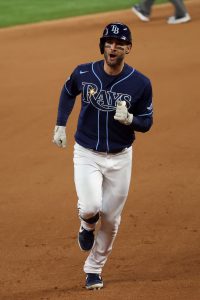Much has been written about the Rockies potentially trading stars Nolan Arenado and Trevor Story. There has been decidedly less chatter about starter Jon Gray. On the surface, though, the right-hander looks to be one of the more sensible trade candidates around the league.
That’s mostly a function of his contractual status. Gray has five years and sixty-two days of MLB service, meaning he’ll hit free agency at the end of next season. Meanwhile, contending in the NL West will be an uphill battle for the Rockies. The Dodgers are a perennial juggernaut, while the already-contending Padres made a trio of impact additions last month. The Giants also had a decent 2020 season; the Diamondbacks did not, but Arizona has largely the same roster that won 85 games and finished second in the division the year before. As Dan Szymborksi of FanGraphs examined this week, the Rockies look more likely to finish near the bottom of the division than the top.
Colorado projects as a longshot for the postseason, particularly if MLB returns to a five-team-per-league playoff structure in 2021. There’s a case to be made the Rockies should move short-term players for future value. The organization needn’t embark on a full rebuild, but a single year of production from Gray (or Story, for that matter) would probably be worth more to another team than it would to Colorado.
Admittedly, Gray is coming off a dismal season. He pitched just eight games with terrible results before being shut down with inflammation in his throwing shoulder. Gray’s velocity, strikeout and ground ball rates all dropped precipitously from past seasons. He ultimately posted an ERA just under 7.
Yet the former third overall pick looked like a capable mid-rotation starter entering 2020. Over the three prior seasons, Gray pitched to a 4.31 ERA (a deceptively solid mark in the hitters’ haven of Coors Field) across 432.2 innings. In that time, his strikeout (24.2%), walk (7.5%) and ground ball (48.8%) rates were each better than league average. As is, Gray was a productive starting pitcher. There remained some hope the former top prospect could yet emerge as a top-of-the-rotation arm. His fastball was in the mid 90’s and he flashed a pair of swing-and-miss breaking pitches.
After his disastrous 2020, Gray would be a reclamation project. But it’s easy to imagine plenty of contenders having interest in acquiring him. Eight poor starts don’t negate what Gray had achieved in the seasons before. His ending last season on the injured list is a red flag, but it’s notable the Rockies seemingly believe he can return to form this year. Otherwise, it wouldn’t have made sense for the Colorado front office to tender him an arbitration contract, projected in the not-insignificant $6MM range, as they did in November.
There has been no indication the Rockies are actually exploring trades involving Gray this offseason. On paper, though, Colorado looks a reasonable bet to subtract short-term pieces from the major league roster. Gray’s pre-2020 track record and past flashes of high-end raw stuff could entice some teams closer to contention to call the Rockies, particularly in a winter without many obvious rotation upgrades available in free agency.


